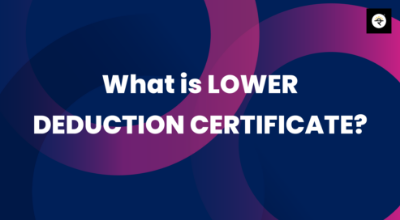What is Lower Deduction Certificate?
A Lower Deduction Certificate (LDC) is a document that certifies to the tax authorities that a taxpayer is eligible for a reduced rate of tax deduction at source (TDS).
The LDC helps taxpayers avoid getting higher TDS deducted than their actual tax liability. It eliminates the unnecessary blockage of funds caused by TDS deduction, even if the recipient has no earnings liable to tax for the year, which can only be claimed as a refund by filing an income tax return. Essentially, it helps you keep more of your money upfront instead of waiting for a tax refund later.
When Should You Consider Applying for a Lower Tax Deduction Certificate?
The TDS rates for non-residents are comparatively higher than residents and hence non-residents do face the brunt of higher TDS deduction even when the income generated out of that transaction is below the basic exemption limit or the tax liability on that income is pretty less. A non-resident can choose to apply for a LDC with the Income tax department before entering into such transactions.
Now, let us understand the use cases for LDC by way of a case study:
Case 1:
An Indian citizen working in India gets an opportunity to go overseas and work there, after working there for a few years, he decided to settle down there and sell his house in India. He had purchased this property several years ago for INR 1.20 crores. He started to scout for a buyer and finally he found one and the deal was finalised at INR 1.8 crores.
The Inflation adjusted cost of this property comes out to INR 1.60 crores (this is the amount considered as purchase price under Income tax laws). He made a taxable gain of INR 20 lacs on this transaction. On this gain, he is supposed to pay tax @ 20% + applicable surcharge and cess i,e INR 4.16 lacs. (Here, we assume surcharge to be 0% and cess @ 4%)
Now, as per Indian Income tax laws, when a non-resident sells property in India, the buyer is required to deduct TDS at a rate of 20.8% (Here, we assume surcharge to be 0% and cess @ 4%) on the amount of sale consideration before making payment to the property seller. This amount comes out to a whopping INR 37.44 lacs.
The seller will file his ITR and offer a tax of INR 4.16 lacs and claim the balance refund of INR 33.28 lacs.
Now, instead he can choose to apply for LDC with a TDS rate of say 2.50%, in this case the buyer will deduct TDS only at 2.50% which will amount INR 4.50 lacs only. In this way, he can unblock an amount of INR 32.94 lacs. This is how a LDC can be utilised for better fund management.
Case 2:
Similarly, if he wishes not to sell this property in India but to rent it, he found a tenant and agreed the monthly rent of INR 25,000 per month (INR 3.00 lacs p.a) in this case the tenant will have to deduct TDS at 30% (TDS rate for rent payments to non-residents is 30%) + cess and surcharge. Assuming, he has no other income in India, the total income from rental will be INR 2.10 lacs (Rent of INR 3.00 lacs and a standard deduction of INR 0.9 lacs), now this amount is even below the basic exemption limit of income for tax in India. Since, he will not have any tax liability at the end of the year, he can choose to apply for LDC with TDS rate of 0% and save the blocking of funds.
Although, in both the cases, he will be eligible for a tax refund of the TDS amount after adjusting his tax liability but the funds will be blocked till the time he files his ITR.
How can you obtain this LDC?
For making an application for LDC, an applicant needs to prepare and arrange various supporting documents like computation of income, proof of residential status etc. These documents need to be submitted along with the application to the Income tax department.


